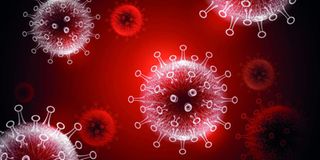Premium
Covid-19: Virus mutation points to greater infection rate

Covid-19 infection medical illustration. Scientists say the novel coronavirus has mutated to a more transmittable form. PHOTO | SHUTTERSTOCK
What you need to know:
- The mutation — G614 — affects the spike protein which the virus uses to invade human cells
- Researchers however acknowledge that the virus has mutated at a very slow pace and “the new copies are not far off from the original virus” which actually is beneficial to vaccine developers.
The novel coronavirus has mutated to a more transmittable form, worrying researchers around the world about the implications.
In a shared global database of Sars-CoV-2 genomes (Nextstrain, GISAID), 70 per cent of the 50,000 genomes of the new coronavirus uploaded in the system carry the new mutation, and it is sweeping across the world, research shows.
The mutation — G614 — affects the spike protein which the virus uses to invade human cells. It changes amino acid 614 from aspartic acid (D) to glycine (G). The research states that these changes on the spike protein make it more effective and has “enhanced the virus infectiousness.”
NEW STRAIN
The mutation makes it easier for a cell to be infected according to the study by the Scripps Research Institute.
The researchers found that the new strain, which is spreading fast in the US, Europe and elsewhere, is 10 times more infectious than the strain that originally came from Wuhan, China.
Hyeryun Cho, the lead researcher at Scripps Institute, said the mutation appeared to “compensate” for the earlier weakness of the spike protein. She said the mutant G614, is more steady than the original virus D614 and is likely to spread faster.
“These results show SG614 is more stable than SD614, consistent with epidemiological data suggesting that viruses with SG614 transmit more efficiently,” said Cho and co-researchers in the report.
“The epidemiological study and our data together really explain why the (G variant’s) spread in Europe and the US was really fast. … This is not just accidental,” she added.
Although the research published on BioRxiv is yet to be reviewed, another study done earlier by researchers at Los Alamos National Laboratory showed similar results.
ACE2 RECEPTORS
The unpublished research emphasizes that patients with the G variant have more virus in their bodies, “making them more likely to spread it to others.” The research shows that the original strain, D614, “often broke off” when trying to bind to ACE2 receptors in people’s airways, but the mutated form, the G614, is less likely to break off, making it easy to invade cells.
ACE2 (angiotensin-converting enzyme) receptors are molecules on the surface of cells that provide entry for the coronavirus into a cell.
The Scripps research suggests that the G614 could be the dominant form of the virus around US and Europe even though the D614 was the original strain identified in Wuhan.
Despite the fact that the new mutation is more infectious, the good news is that it does not appear more deadly than the original strain.
SLOW PACE
Researchers however acknowledge that the virus has mutated at a very slow pace and “the new copies are not far off from the original virus” which actually is beneficial to vaccine developers.
However, more information is needed to so as to understand implications of the new mutations to research, and the general population around the world.
Some of the information needed is about whether re-infections, after a patient recovers, is possible, and whether the mutation could affect vaccines and drugs being developed.
In March, researchers had identified 14 strains of Sars-CoV-2 in the US while in Kenya, scientists at the Kenya Medical Research Institute (Kemri) identified at least nine strains of Sars-CoV-2 which had been imported into the country before April 30.
The novel coronavirus is spreading fast in the country having an established community transmission. Epidemiologists have predicted that infections in the country will continue to rise and the number will not go down until the virus peaks from September.





